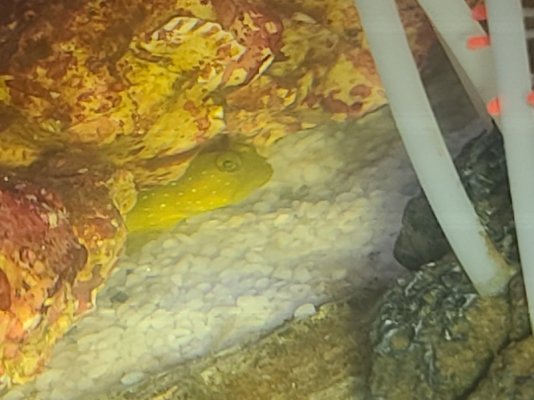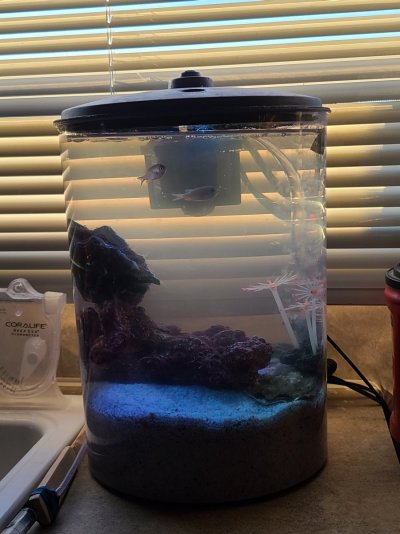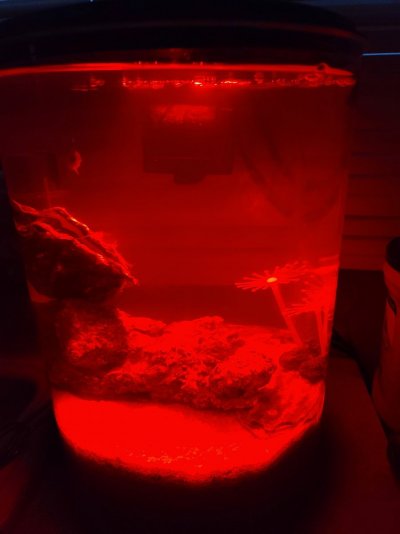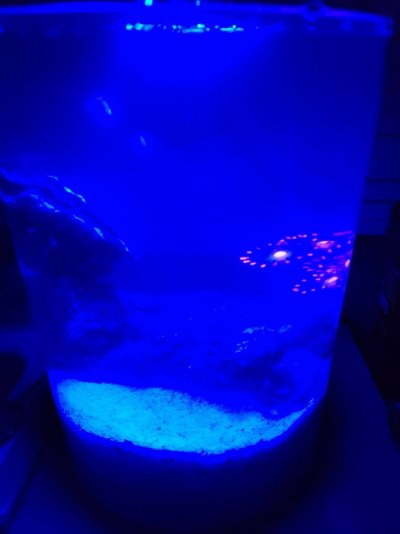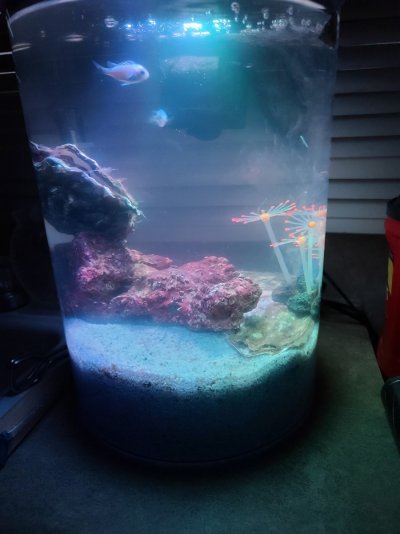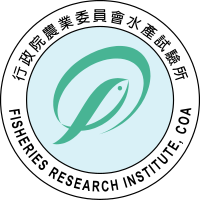So far I have expected to see nitrates and nitrites go up, but now that I will be spot feeding the oyster I hope to see them go down from where they are, barely registering. Pacific oysters are named invasive almost everywhere! however in places like Chesapeake bay it seems to be extremely beneficial where the native species of oyster was nearly destroyed and its ecosystem collapsed, Thankfully the farming of pacific oysters there is helping the government to strategically repopulate and rebuild the once famous oyster reefs. Only this time, with a mix of native oysters, and pacific oysters.I have two pacific oysters in my macro algae display. They are invasive along the Tasmanian coast so I collected them from my local bay.
I didn't realize they could potentially reduce nitrates so I'll start monitoring. I'm really interested to see what comes up in your closed systems!
Navigation
Install the app
How to install the app on iOS
Follow along with the video below to see how to install our site as a web app on your home screen.
Note: This feature may not be available in some browsers.
More options
You are using an out of date browser. It may not display this or other websites correctly.
You should upgrade or use an alternative browser.
You should upgrade or use an alternative browser.
I researched then added a fresh live grocery store oyster to my pico.
- Thread starter steven_d_blanshan
- Start date
- Tagged users None
I do allow about 20 minutes a day of minimal natural evening sun light to shine around the window shades and into the tank. later tonight I will use only the dim red LED to see into the tank in the dark, the fish do not seem to see the color red, all other colors they act as if it is day time, with the red light the fish go to their usual sleeping spots. Except the goby who prefers the dark and comes out to play when the red light is on. I'll upload a photo of that later.
I'm curious if the oysters reputation of minus nitrate-nitrite is true for a single oyster as well as the oyster reef has proven to be, is it a negative net nitrogen member of the cleanup crew which can be hidden away in some part of my later reef?
I'm curious if the oysters reputation of minus nitrate-nitrite is true for a single oyster as well as the oyster reef has proven to be, is it a negative net nitrogen member of the cleanup crew which can be hidden away in some part of my later reef?
Attachments
My 3 main illumination choices, just measured nitrate and nitrite, both are at safe levels... My only concerns are nitrate at 30 ppm and nitrite at 0.7 ppm. Both safe for these inhabitants for a short time, and I am expecting to see a drop in those after recent changes to feeding method and the addition of various algae within the next few days.
I am surprised how much is similar to a typical reef, I even use words like shell frags instead of coral frags, and even though I haven't had much interest in reef biotypes before, I'm suddenly understanding more about them from learning about both during this experiment. Only now do I realize there is a whole reef type of fluorescent and bioluminescent reef dwellers, and I am excited!
I am surprised how much is similar to a typical reef, I even use words like shell frags instead of coral frags, and even though I haven't had much interest in reef biotypes before, I'm suddenly understanding more about them from learning about both during this experiment. Only now do I realize there is a whole reef type of fluorescent and bioluminescent reef dwellers, and I am excited!
Attachments
Today I found the oyster mostly dead after only 4 days, I thought he was a healthy one... so after a 90 percent water change I am going to do further research... as I understand it, he should have been fine... I have 6 more live oysters today, I saved any potential hitchhikers in the sealed biome, and I will take a break from live oysters in the tank for now. instead... I will continue to collect the mud and sand from their shells and add shell frags as new critters are found... I'm concerned that I'm missing something, the temps and water parameters are good according to all my research, and i would rather eat them then kill them in my tank... so a brief oyster break is due.
Oysters need a lot of food to not starve, and they are, in fact, coldwater. They're hard to keep alive in larger tanks, never mind a pico. Maybe in a larger tank they can use up nitrates, if they don't need food. But if you're having to add a bunch more nitrates to keep it fed, it's only increasing the amount of stuff in the tank.
Also, that tank is too small. Even if you manage to keep the water clean enough, those fish need more space to move. You should not have 3 fish that will all hit 3" in a 3.5gal tank. That's appropriate stocking for more like a 20gal, maybe a 15. The only fish suitable for a tank that small are tiny gobies that perch and don't swim much, like trimma gobies. A roughhead blenny could also work, they hit about 1.5" but are very slender and don't really swim around.
Also, that tank is too small. Even if you manage to keep the water clean enough, those fish need more space to move. You should not have 3 fish that will all hit 3" in a 3.5gal tank. That's appropriate stocking for more like a 20gal, maybe a 15. The only fish suitable for a tank that small are tiny gobies that perch and don't swim much, like trimma gobies. A roughhead blenny could also work, they hit about 1.5" but are very slender and don't really swim around.
The optimal salinity and temperature in lab tests for breeding were 26-32°C and 15-25 ppt, respectively. with survivability being below 0 C and above 95 F with between 10 and 40 ppt for this species.I thought oysters were a coldwater species? I don't know if it will be able to survive in a warmer environment
Update; Nitrite is 0, nitrate is almost 0, I added marine algae and yesterday I noticed the oysters were especially fresh at the store, with all barnacles and hitchhikers still intact and alive, so I allowed 24 hours in a quarantine where I removed a bristle worm, an unknown tubifex like worm, and the oysters spawned as I slowly increased the temp from 40 F to 72 F and the salinity from 18ppt to 25 ppt.
One of the 3 oysters was especially vigorous, visibly pumping enough water to break the surface and create a clear circular current in the small tank so this female is going in for another try.
Another note, the "diadumene paranaensis?" very similar to a smaller white or clear aiptasia has stopped growing with the bell being less than 1/2 inch and has 7 offspring, all on the same shell frag.
back to oysters, I found this...
The effect of salinity and temperature on the settlement of the pacific oyster, Crassostrea gigas, was studied. Firstly, the activity of the competent pediveligers, eyed-larvae (348.6 ± 26.1 μm in total length), in seven salinities (10, 15, 20, 25, 30, 35 and 40 ppt) and six temperatures (16, 21, 25, 27.5, 30, and 35°C) were observed. The competent pediveligers were tolerable to wide salinity (10-35 ppt) and temperature (21-35°C). Secondly, the effects of five salinities (15, 20, 25, 30, and 35 ppt) and five temperatures (23, 26, 29, 32 and 35°C) on the settlement of eyed larvae were tested. The optimal salinity and temperature were 26-32°C and 15-25 ppt, respectively.
considering I spot feed phytoplankton with a long pipette and the temps and salinities are acceptable, I figure perhaps my failure so far has been acclimation?
One of the 3 oysters was especially vigorous, visibly pumping enough water to break the surface and create a clear circular current in the small tank so this female is going in for another try.
Another note, the "diadumene paranaensis?" very similar to a smaller white or clear aiptasia has stopped growing with the bell being less than 1/2 inch and has 7 offspring, all on the same shell frag.
back to oysters, I found this...
considering I spot feed phytoplankton with a long pipette and the temps and salinities are acceptable, I figure perhaps my failure so far has been acclimation?
Similar threads
- Replies
- 5
- Views
- 140
- Replies
- 1
- Views
- 206
- Poll
- Replies
- 3
- Views
- 105
- Replies
- 4
- Views
- 134



